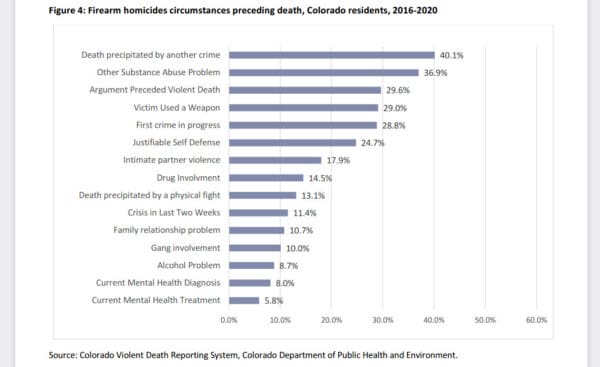Colorado Finds 1 in 4 Homicides with Firearms are ‘Justifiable Self Defense’
The number of times firearms are used in self-defense is difficult to quantify. In a rare analysis of data concerning deaths related to firearms, the Colorado Center for Health & Environmental data has produced figures that indicate firearms are commonly used for self-defense.
The Colorado Department of Public Health and Environment analyzed 5,287 firearm-related deaths in Colorado from 2016 to 2020. Of those deaths, the vast majority, 73.6%, were suicides. 24.9% were homicides/assaults (about 1316). Of the homicides, 24.7% were justifiable self-defense (about 325).
Firearms availability has minimal if any, effect on overall suicide rates. Firearms availability may increase or decrease overall homicide rates. The preponderance of the evidence is the availability of firearms has either no effect or slightly reduces overall homicide rates. Increasing legal firearms carry appears to have a small but measurable effect in decreasing overall homicide rates.
The 24.7% of firearms homicides is plausible. However, the number of justifiable homicides is seldom compiled and recorded in official statistics. The FBI records some justifiable homicide data, but the FBI’s definition of what is recorded as a justifiable homicide is extremely limited. Studies of overall homicide data compared to what is reported and recorded by the FBI indicate actual numbers of justifiable homicide are about five times those recorded in the FBI Uniform Crime Reports (UCR). The UCR was changed to an event-based system, so UCR data is only available through 2019.

Compiling the UCR data from the four years, which overlap the Colorado statistics (2016, 2017, 2018, and 2019, show 2790 justifiable homicides (police and other citizens) and 42,115 non-justifiable homicides with firearms. Those numbers translate as 6.2% of firearms homicides were recorded as justifiable under the extremely limited FBI definition. Given the studies to indicate only 1 in 5 justifiable homicides are recorded in the UCR, the national figure would be 31% of firearms homicides are justifiable for the four overlap years. This is reasonably close to the 24.7% in the Colorado fact sheet, considering there are significant differences between states.
There is significant bias in these numbers. Most people committing murder intend to kill their victims. Most people defending themselves kill their assailants as a last resort. The number of deaths by intent tends to be larger for illicit killing than for justifiable killing. Firearms are much more commonly used to defensively prevent an attack than to kill an attacker. In cities such as Chicago, the number of people wounded and requiring hospitalization is about five times the number killed with firearms. Similarly, the number fired at without effect appears to be several times the number wounded. Finally, the number of people deterred from an attack by the presence of a firearm is likely several times the number of incidents where the firearm had to be fired.
Surveys of defensive uses of firearms indicate the total number of defensive uses is roughly 1-3 million per year. Successful defenses are unlikely to be reported or recorded if no shots were fired or no one was injured.
As a rough check on possibilities, if there are 13,000 homicides committed with firearms in a year, 30% of those would be 3,900 justifiable homicides. Six times that number to include wounded as well as killed would be 23,400. Four times that number where shots are fired but no one hit would be 93,600. Ten times that number, to include times when no shots are fired would be 936,000, or nearly a million defensive uses. While plausible, all of the above numbers are not easily determined because of a lack of official reporting and recording.

